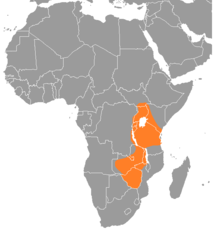Lesser cane rat
| Lesser cane rat | |
|---|---|
| Scientific classification | |
| Kingdom: | Animalia |
| Phylum: | Chordata |
| Class: | Mammalia |
| Order: | Rodentia |
| Family: | Thryonomyidae |
| Genus: | Thryonomys |
| Species: | T. gregorianus |
| Binomial name | |
|
Thryonomys gregorianus (Thomas, 1894) |
|
 |
|
The lesser cane rat (Thryonomys gregorianus) is a species of rodent in the family Thryonomyidae. It is found in Cameroon, Chad, Democratic Republic of the Congo, Ethiopia, Kenya, Malawi, South Sudan, Tanzania, Uganda, Zambia, Zimbabwe, and possibly Mozambique. Its natural habitats are subtropical or tropical dry shrubland, subtropical or tropical dry lowland grassland, and shrub-dominated wetlands.
The lesser cane rat grows to a length of about 38 centimetres (15 in), about one quarter of which is the tail. It has a weight of up to 7.5 kilograms (17 lb) and males are usually larger than females. The hair is coarse and rather bristle-like and lies flat against the body. The ears are small and almost hidden in the fur. The feet are long with three functioning toes, bare palms and strong claws. The back and sides of the animal are yellowish- or greyish-brown and the underparts greyish-white. The tail has a few bristles and scales and is brown above and white below.
Its karyotype has 2n = 40 and FN = 80.
The lesser cane rat is native to Central and East Africa and the more northerly parts of southern Africa. The main parts of its range are southern Sudan, the whole of Uganda, western Kenya, Tanzania, Zambia, Malawi and Zimbabwe but it also occurs sporadically in some of the neighbouring countries. It is found in open grassy countryside, the fringes of marshland and in woodland and it has been recorded at an altitude of 2,600 metres (8,500 ft) above sea level in the Rwenzori Mountains. It occupies much the same range as the greater cane rat (Thryonomys swinderianus) but that species is more aquatic and frequents river banks and lakesides.
...
Wikipedia

